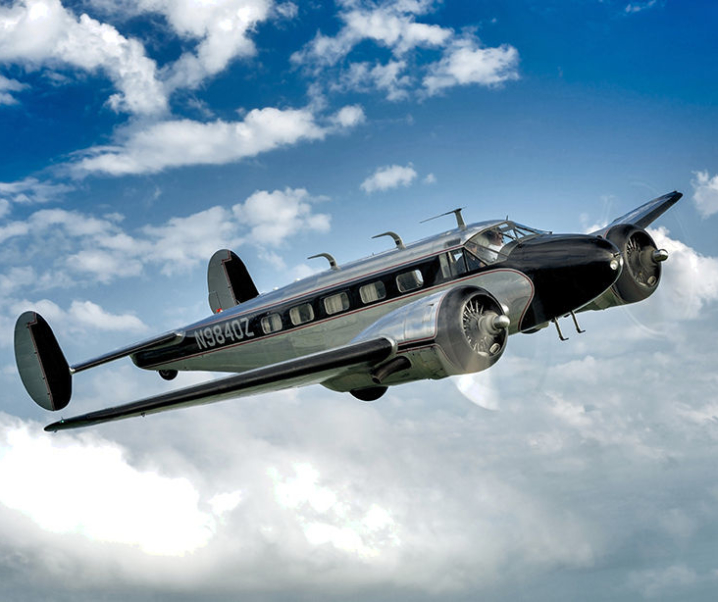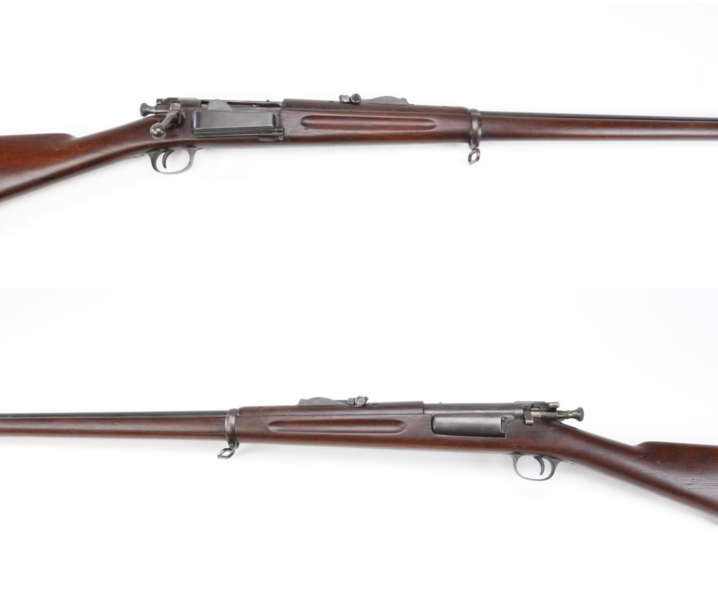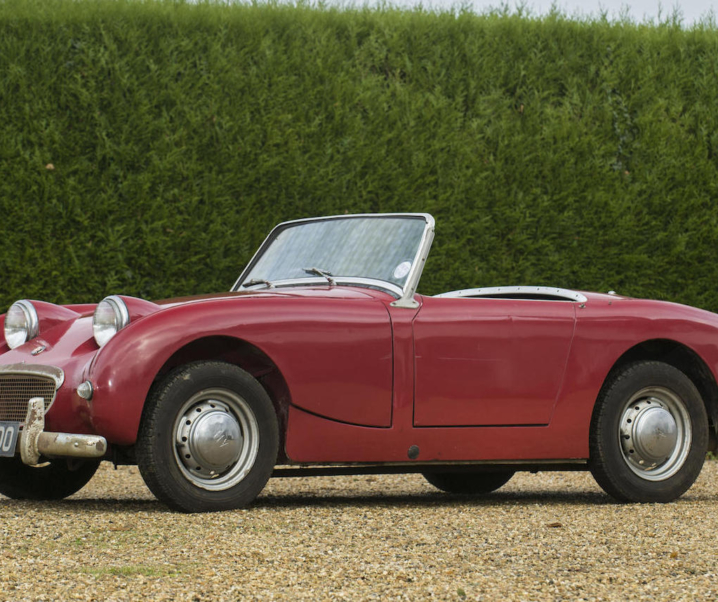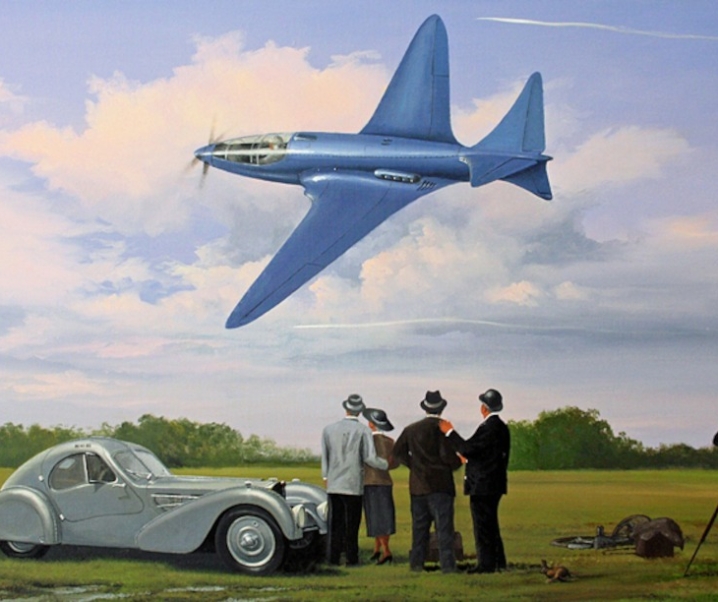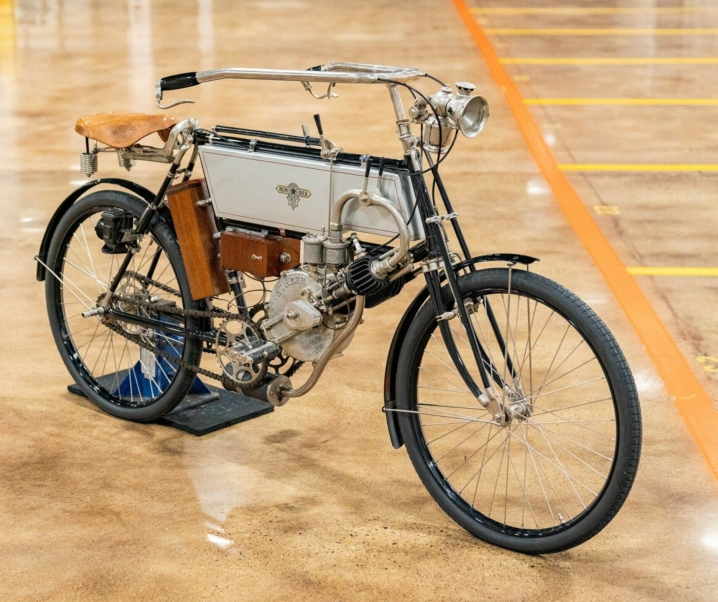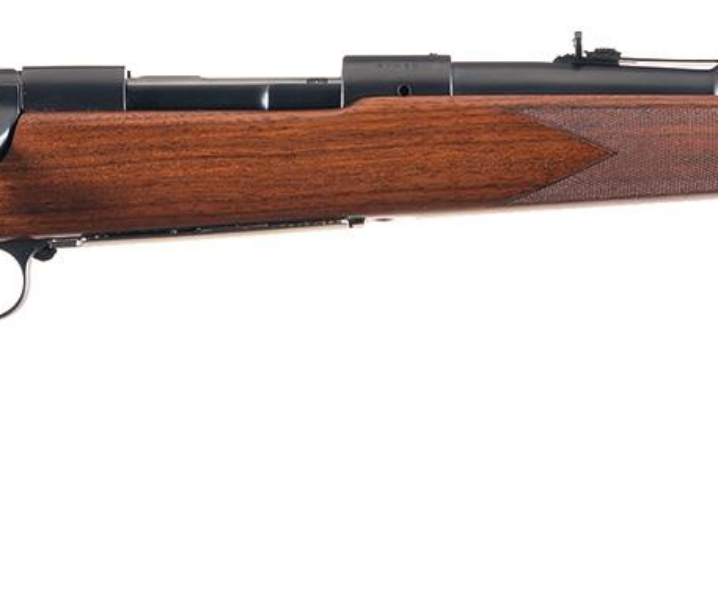The Krag-Jørgensen was a visionary design when it was first created and it stands out as one of the great rifle designs of the nineteenth and twentieth centuries.
This rifle blended a butter-smooth bolt action with a unique half-capsule magazine and was so well thought out and made that it served Denmark and Norway up until the Second World War and beyond.
Fast Facts
- The Krag-Jørgensen was born out of Ole Krag’s initial rifle design, the Krag-Petersson, from which he learned the practical lessons needed for his design for a truly practical military rifle.
- The Krag-Jørgensen was first designed around 1885, in the era when the military forces of the world were making the migration from big-bore black-powder rifles to the high velocity ammunition and repeating rifle actions made possible by the new technology of nitro propellants.
- This rifle design would become the main service rifle for the United States, Denmark and Norway.
Background History
To understand the development and adoption of the Krag-Jörgensen rifle in Europe its helpful to have a quick look at a segment of the background of the intertwined history of Denmark, Norway and Sweden.
Sweden and Norway were joined as The United Kingdoms of Sweden and Norway from 1814 until that union was peacefully dissolved in 1905. This means that during the period when they were making the move from black-powder rifles to nitro-powder rifles for their military forces the two were joined together.
While this might have been expected to result in both Sweden and Norway adopting the same standard rifle using the same cartridge this would in fact not occur. As Sweden and Norway were moving towards independence of each other they would finish up using the same cartridge, but different rifles.
The story of the Krag-Jörgensen, which would become the standard military rifle for the United States, Denmark and Norway, began back in 1885, when the work of Alfred Nobel would result not only in the creation of Dynamite, but also of the nitro based explosives that would make repeating rifles far more reliable, and which would make machine guns possible.
The prime mover in the development of a new infantry rifle intended for Denmark, Norway and Sweden was Ole Herman Johannes Krag, who was an officer of the Norwegian army.
Lieutenant Krag’s talent for firearm design was recognized in 1866, at which time he was transferred to the Kongsberg Våpenfabrikk, which was the government arms factory.
In his new role at the arms factory Krag began with a design for a repeating rifle which he then developed in collaboration with Axel Petersson to create the Krag-Petersson rifle.
The Krag-Petersson
The Krag-Petersson was designed in 1872, and adopted as the standard rifle for the Norwegian Navy in 1876.

This rifle was fitted with a ten round tubular magazine mounted under the barrel and was chambered for the black-powder 12.17x44mm RF rimfire cartridge (i.e. 12.17x44RF) which sent its bullet downrange at a respectable 1,250 ft/sec (381 m/sec).
The rifle featured a falling-block action which had its operation simplified by using a large hammer as the means not only of firing, but also of opening the action, extracting the spent cartridge case, and raising up a fresh cartridge from the magazine ready for the rifleman’s thumb to push it into the chamber.
To operate the action after a shot the rifleman would simply pull back the large hammer which would extract the fired case and place a fresh cartridge from the magazine on the breech-block/lifter.
With the fired case removed the hammer was partly released which would raise the fresh cartridge and align it with the chamber, at which point the rifleman would use his thumb to push the fresh cartridge into the chamber: the hammer was then released which would allow the breech-block to spring up into the closed position, and the rifle could then be fired.
This was a simple and ingenious design that seems to have worked well as the video below from Kemomimisky on YouTube shows.

(Note: A centrefire version of the 12.17x44RF was created along with a conversion kit to change the Krag-Petersson rifle over to use centrefire ammunition. This was the 12.17x44R and as can be seen in the above video that is the cartridge in use for that rifle).
The Krag-Jörgensen is Born
As can be ascertained from our look at the Krag-Petersson there was a great deal of room for improvement. It was a bit like the US Trapdoor Springfield, with perhaps having some advantage because of its ten round magazine.
In 1884 Norway adopted a new bolt-action rifle with a tube magazine that was not a Krag design. This was the M1884 Jarmann rifle which had been designed in 1876, and it was chambered for the 10.15 x 61R centrefire black-powder cartridge.
The M1884 Jarmann had an eight round tube magazine fitted under the barrel as had been the case for the Krag-Petersson but its operation was much less fiddly than the Krag-Petersson.
Ole Krag, who by this time had been promoted to the rank of Captain and Director of the Government Arms Factory Kongsberg Våpenfabrikk saw that something superior was going to be needed and so he set about trying to design a bolt-action repeating rifle that would be smooth to operate, easy to reload, and reliable.
He got together with friend and master gunsmith Erik Jørgensen and together they set about a process that would involve the merging of some elements of established technology along with some new creative thinking.
Krag wanted to keep the capacity of a ten round magazine and have it in a smooth operating bolt-action rifle. Erik Jørgensen came up with a solution to this problem by inventing a unique “capsule” magazine that literally wrapped around the rifle’s bolt-action.
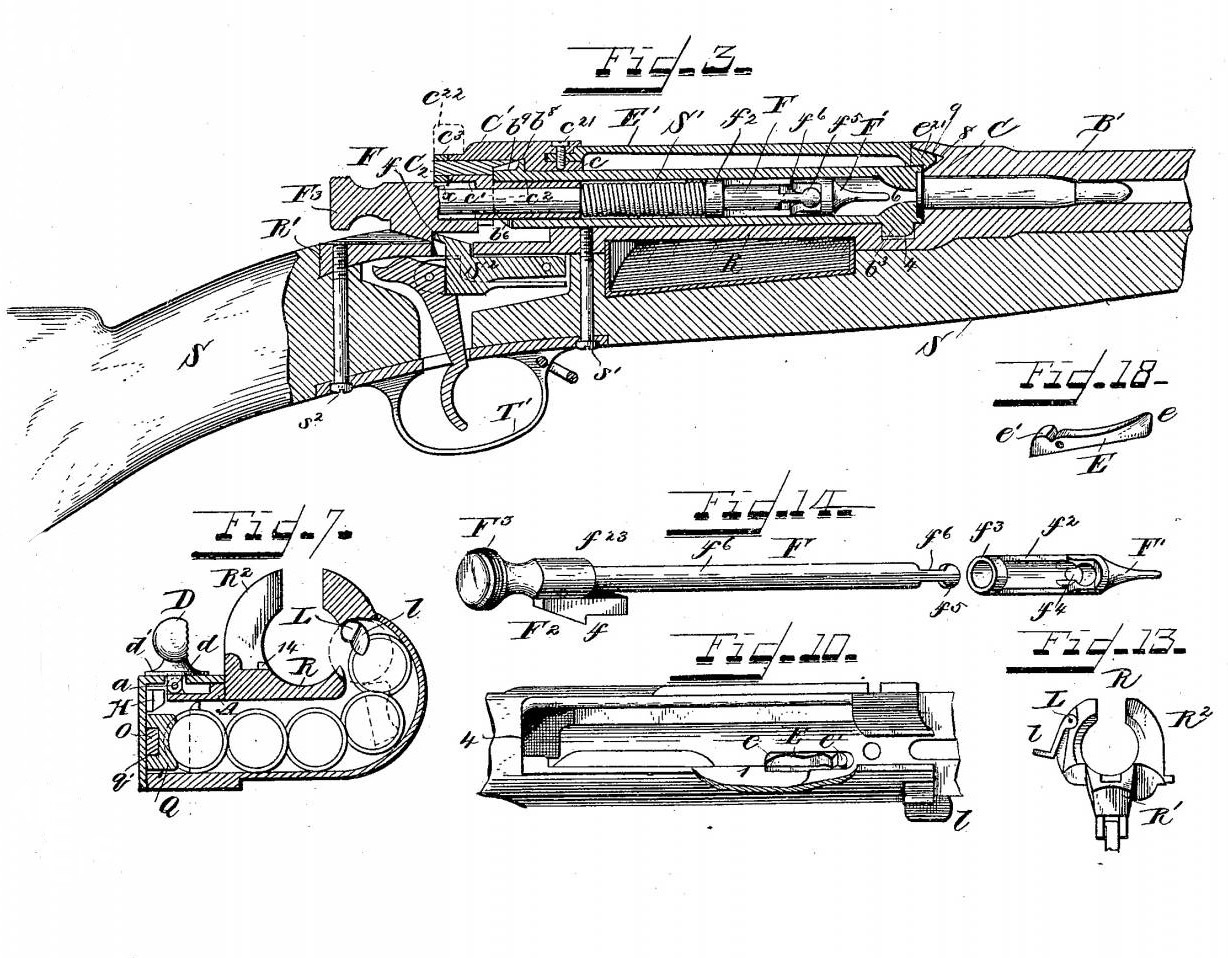
The first potential customer for a new Krag rifle was neighboring Denmark and so prototype Krag-Jørgensen test rifles were sent to the Danes for evaluation by their military forces.
The result of that evaluation was that the prototype with its full capsule ten round magazine was too heavy and needed to be made significantly lighter.
There was only one area in which that lightening process could take place, and that was in reducing the capacity of the Jørgensen full capsule magazine.
Erik Jørgensen decided that the best solution to the problem was to halve the magazine capacity which instantly reduced both rifle weight and bulk. His new half-capsule magazine featured an opening box to the right of the action below the ejection port into which cartridges could be randomly dropped as long as all the points were in the correct orientation, the magazine door could then simply be closed and all the cartridges would be automatically aligned ready for cycling through the action.
It was, and still is, a very clever and practical design.
Ole Krag got busy on the bolt-action design. He tried a dual front locking lug action but found it too complex and awkward when combined with the Jørgensen half-capsule magazine. So he settled on a single right side locking lug. This permitted excellent access to the breech face, and would allow for a stuck cartridge case to be pried free with a knife blade if needs be.
Krag decided to use a full length claw extractor, and placed it on the top of the bolt, necessitating a split-bridge receiver. Sitting underneath the extractor was an anti-bind rail on the bolt to ensure a butter-smooth bolt operation.
The anti-bind rail turned down into the ejection port when the action was closed and provided a backup lug in case the single front locking lug failed.
The Danish Krag-Jörgensen
The Danish military authorities were impressed enough by the Krag-Jørgensen that they adopted it as their standard military rifle beginning on 3rd July, 1889.
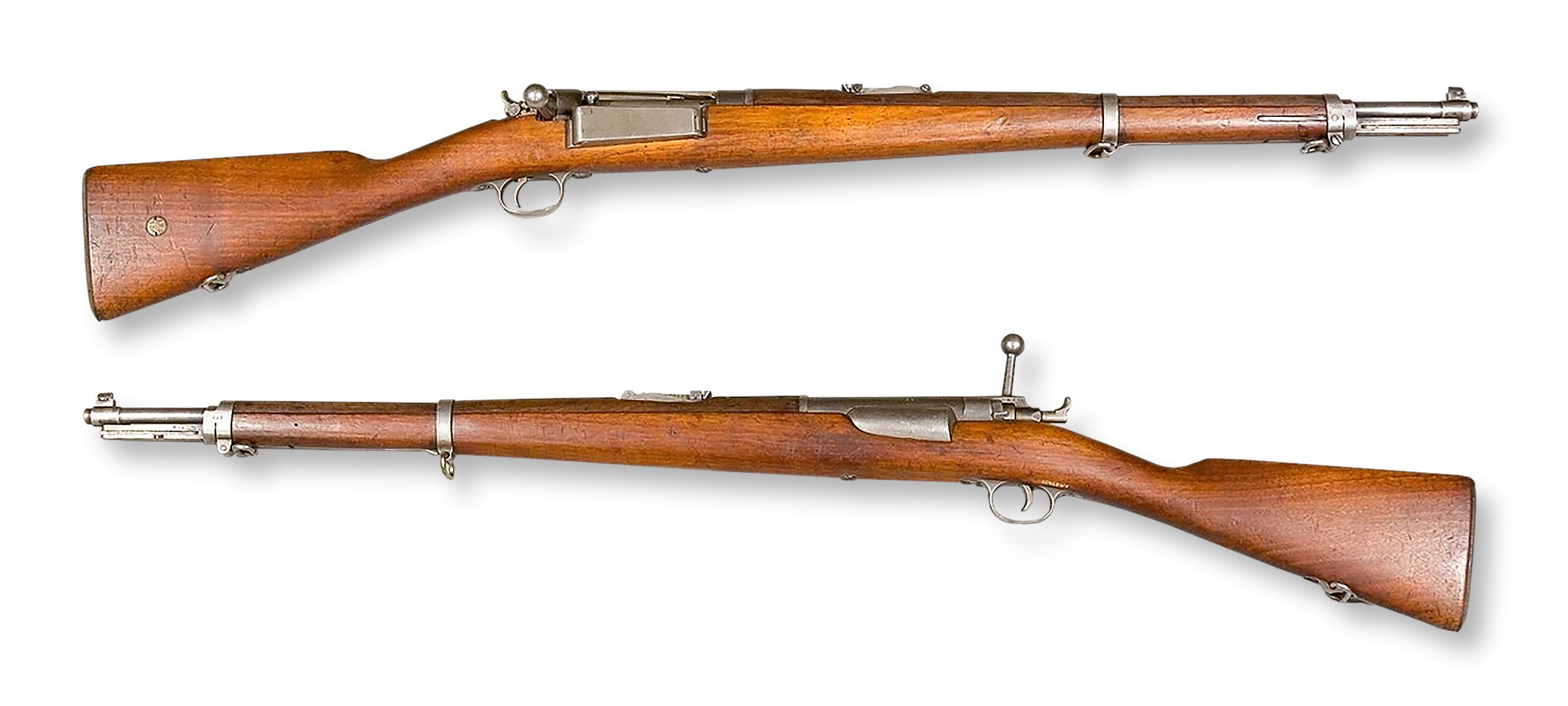
The Danish Krag-Jørgensen rifles exemplify the early design thinking of Ole Krag and Erik Jørgensen and, as such, have notable differences to the Krag-Jørgensen rifle designs adopted by Norway and the United States.
On the Danish Krag-Jørgensen the magazine box door is vertically hinged at the front and opens out to the right and forward whereas the Norwegian and US Krags have their magazine box doors horizontally hinged so they open out and down to act as a catcher for the cartridges being dropped into the magazine.
To load a Danish Krag the magazine box door is swung open forward and the rifle turned over to the left to allow the cartridges to be dropped/pushed into the magazine without having them spill onto the ground. Care has to be taken that the magazine door stays open, and care also has to be taken to ensure that bullet points are not snagged in the front mounted magazine box door hinge.
The Danish Krag-Jørgensen was fitted with a magazine cut-off so the magazine could be held in reserve while the rifle was used as a single shot. The magazine cut-off switch was located on the left side of the receiver bridge.
One of the advantages of Erik Jørgensen’s half-capsule magazine was that it could be topped up with fresh cartridges without the need to open the bolt. The shooter could have a round “up the spout” and open the magazine box and insert the required number of fresh cartridges.
The Danish Krag-Jørgensen’s bolt handle sticks out horizontally when closed and is rotated up to vertical when the action is opened.
The operation of the Danish Krag-Jørgensen is demonstrated in this video courtesy C&Rsenal.
As originally issued the Danish Krags did not feature a safety catch. Instead they were fitted with a curved manual cocking piece with a half-cock and full-cock: the half-cock supposed to serve as the safety.
This was subsequently improved on in 1910 by the fitting of a safety catch as a switch located just behind the bolt handle root when the action was closed. When the safety switch was pushed forward it locked the trigger and also locked the bolt handle closed by a tab of steel that moved over the bolt handle root to keep it closed.
The safety was disengaged by thumbing it back towards the shooter.
An unusual feature of the Danish Krag-Jørgensen was its sleeved barrel. The rifle’s floating barrel was suspended inside a steel barrel sleeve, presumably to provide protection for the barrel in the rigours of combat use and possibly to improve accuracy and consistency. This of course added to the weight of the rifle.
The knife style bayonet attached to a bayonet lug on the barrel-sleeve.
The Danish Krag-Jørgensen rifles were made in a variety of configurations, not all of which are documented.
- Gevær M/89 (Rifle M/89): a full-length infantry rifle with wood stock almost to the muzzle end of the barrel-sleeve.
- Rytterkarabin M/89 (Cavalry Carbine M/89), Ingeniørkarabin M/89 (Engineer Carbine M/89), Artillerikarabin M/89-24 (Artillery Carbine M/89-24), and the Fodfolkskarabin M/89-24 (Infantry Carbine M/89-24.
These variations in the carbines featured minor differences in placement of barrel bands and whether or not a bayonet lug was fitted, location of sling swivels etc.
- Finskydningsgevær M/89-28 (Sniper Rifle M/89-28).
The sniper rifle was a heavy barrel model made for accuracy and was fitted with a micrometer rear sight and hooded front sight.
The Danish Krag-Jørgensen rifles were chambered for the 8x58R centrefire cartridge. The cartridge case was created by necking down the Danish 11,4x51R Remington Rolling Block rifle cartridge to accept an 8mm (.323 inch) projectile.

This cartridge fired a 237gn (15 gram) round nose projectile at a muzzle velocity of 2,460 ft/sec (750 m/sec) for a very respectable 3,185 ft/lb (4,318 J) of energy.
The Danish 8x58R would be updated in 1908 with a 196gn (13 gram) aerodynamic spitzer bullet at a muzzle velocity of 2,530 ft/sec (770 m/sec) producing energy of 2,786 ft/lb (3,777 J).

The 8x58R would also become a sporting/hunting cartridge and used with appropriate bullets would prove to be adequate for Scandinavian game including moose.
It is still possible to obtain cartridge cases and ammunition, although those shooting this cartridge need to ensure they have their rifle examined by a competent gunsmith before use. 8x58R rifles can be subject to headspace variations for example.
8x58R cases can be made from 45-70 brass but the cases must be annealed before forming.
The Danish Krag-Jørgensen rifle remained Denmark’s main service rifle up until the Nazi German invasion of the country in April of 1940 during the Second World War.
The Norwegian Krag-Jörgensen
At the time that Norway and Sweden began work on selecting a new nitro-powder military rifle in 1891 these nations were joined together. So it was the Swedish-Norwegian Rifle Commission who began this work.
The first task undertaken by this working group was to make an open minded evaluation of what ammunition should be adopted – if we think about things as they seem to have done – a rifle is simply a bullet launcher. So, given that the new nitro propellants called for smaller bores and higher velocities combined with efficient repeating magazine fed actions, the choice of cartridge was deemed to be foundational.
This committee progressively arrived at the exact specifications for the new cartridge, which would ultimately be the 6.5x55mm. A rimmed case was considered, as was a semi-rimmed case, but finally to ensure excellent feeding from a magazine a rimless design was fixed upon. The most efficient bore size was determined to be 6.5mm thus using .264 inch diameter bullets in a cartridge case that was 55mm long. The commission determined and agreed upon every aspect of the cartridge and chamber dimensions and loading specifications: the intention was to create a standard for both Norway and Sweden to follow.
By 1893 the commission was working on evaluation of potential rifle designs and undertook a trials program similar to that done by the United States military when they finished up adopting their own version of the Krag-Jørgensen in 1892.
There were three rifles short-listed; the M1892 Mannlicher, M1892 Mauser, and the M1892 Krag-Jørgensen: all of these were turn-bolt action rifles.
The result of the trials was the selection of the locally designed and made Krag-Jørgensen, but the design used by Norway and Sweden was one a little different to that adopted by the Danish military.
The US Springfield version of the Krag-Jørgensen had a re-designed magazine in which the magazine door hinge was set in the horizontal plane so that the magazine door opened outwards and down to effectively make it a catcher for cartridges to be simply dropped in. This was much easier to use and had the added advantage that bullet points were not likely to get caught in the magazine door hinge as could happen with the Danish Krag-Jørgensen.
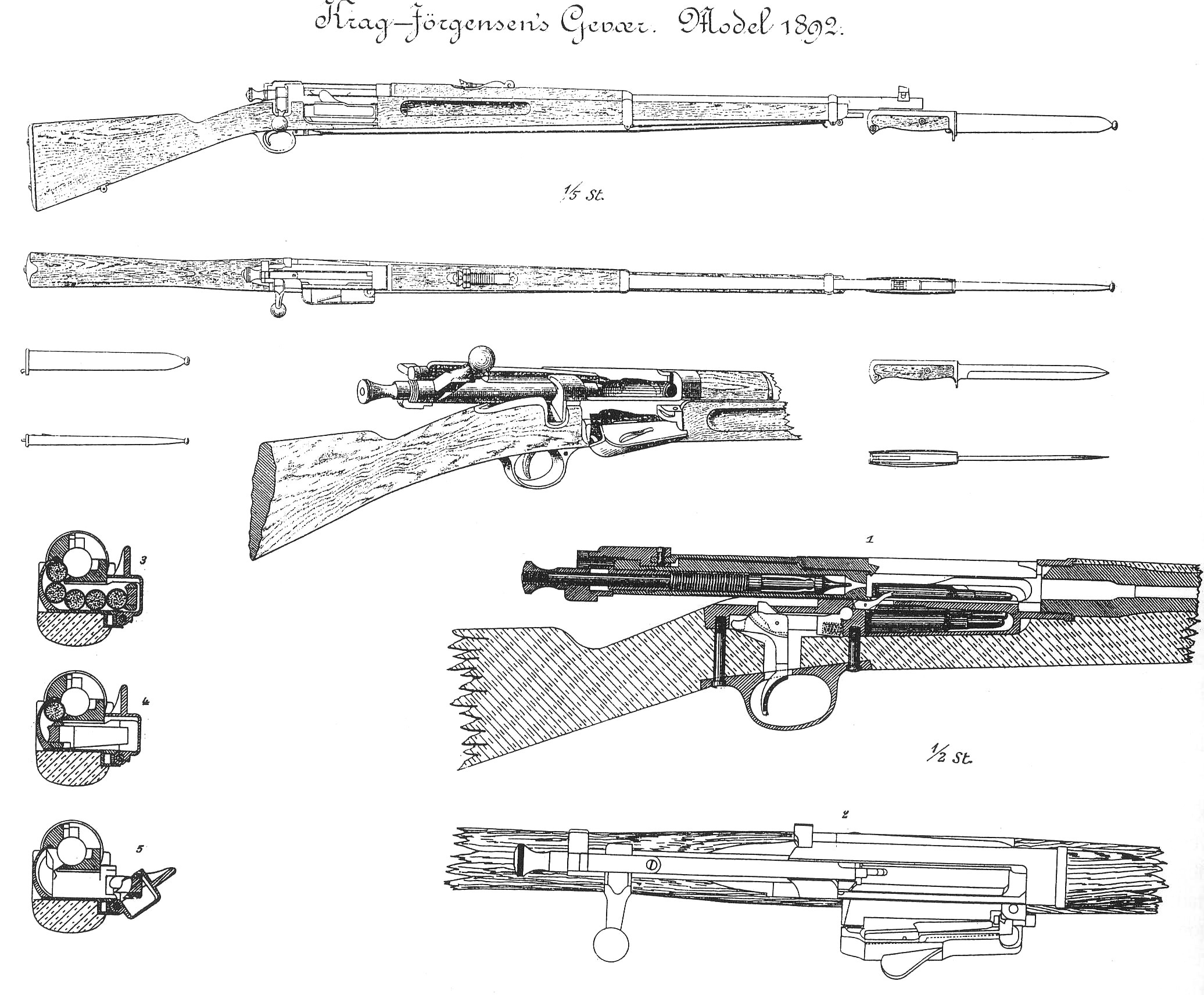
Just like its American counterpart the Norwegian-Swedish Krag-Jørgensen was fitted with a flag safety catch that was moved to the left-horizontal when disengaged and right horizontal when on safe.
The Norwegian-Swedish rifle also had a magazine cut-off switch mounted on the rear left of the receiver.
The barrel of the Norwegian-Swedish Krag-Jørgensen was not sleeved, just as the US version did not have a sleeved barrel either.
As previously mentioned at the time the selection trials for the new Norwegian-Swedish military rifle began the two countries were joined together, but they were moving towards separation into two separate nations.
The Swedes were not entirely enamored with the Krag-Jørgensen rifle and did some looking at other possibilities. They discovered the then new Mauser M1896 which offered a staggered column five round magazine, stripper clip speed loading, and an action that would lock open if the magazine was empty.
This Mauser action had twin front locking lugs with the anti-bind rail acting as a safety backup, and it was a cock-on-closing style action like the British Lee-Enfield which was favored by the British who believed it provided for faster action cycling.
The Mauser M1896 is indeed a smooth action, quick and reliable to use, and when you are using it fast the cock-on-closing is barely noticeable, the momentum of the bolt takes care of the cocking nicely.
The Mauser M1896 was also stronger than the Krag-Jørgensen having two front locking lugs, so it could safely use ammunition loaded to higher pressures.
Sweden decided to go with the Mauser M1896, Norway with the Krag-Jørgensen M1894, and both using the 6.5×55 cartridge.
Just like Denmark, Norway recognized the need to provide specialist rifles for certain branches of its military. So there were a number of variants made as follows:
- The “Long Krag” standard M1894 infantry rifle. These rifles were fitted with 30 inch barrels which, unlike the Danish Krags, were not fitted with a steel sleeve, but just shrouded by the wood of the stock.

There were 122,817 of these rifle made at the Nowegian Kongsberg arms factory with production ending in 1922. Additionally 29,000 were made by Steyr of Austria between 1896-1897 (Note: Some Steyr made Norwegian style M1894 Krag-Jørgensen rifles in 6.5×55 made their way to South Africa during the Second Boer War. These were not of the batch made for Norway under contract).
The Norwegian M1894 rifles feature a flag type safety catch, magazine cut-out, and pistol grip stock.
1910 saw 1,000 of these standard rifles fitted with telescopic sights in special mounts. These were serial numbers #89602-#90601. These were pioneering days of rifle telescopic sights and the system fitted to these thousand sniper rifles proved not to be durable nor consistent enough for combat use.
There would be three further attempts to create a suitable sniper’s rifle; the M1923, a run of 630 rifles which were built between 1923 and 1926. The M1925 which was an improved version of the M1923 and which was made for sale to the civilian market: 1,900 were made from 1925 until 1940 when the Nazi Germans arrived, behaved rather rudely, and stopped Norwegians from enjoying their target shooting.
The last Krag-Jørgensen sniper’s rifle was the M1930 which featured a heavier target style barrel, modified stock design, improved trigger, and new improved sights. This model was regarded as the best of the three and 466 were built between 1930 and 1939.
In addition to these another 404 M/30 rifles were produced, these had laminated stocks and improved rear (diopter) sights.

- The first two styles of carbine were the M1895 cavalry carbine, and the M1897 mountain artillery and engineer carbine, to provide short rifles suitable for those specialized roles. The only difference between the M1895 and M1897 was in how the sling swivels were attached. 9,309 were made between 1898 and 1906.
- Improved versions of the above listed carbines were the M1904 engineer carbine and M1907 field artillery carbine, which were stocked to the muzzle to provide better protection. These were made between 1906 and 1908. 2,750 M1904 and 750 M1907 carbines were made.
- An interesting version of the Norwegian Krag-Jørgensen was the M1906 Guttekarabin (boy’s carbine). These were made for the express purpose of teaching schoolboys how to shoot and handle a rifle safely and competently. These rifles were made with a shortened stock to suit the stature of boys aged 14-17, who were the subjects of this program. The government provided special reduced load 6.5×55 ammunition for use on the reduced size ranges used for this program. 3,321 of these carbines were made and the shooting education program was a part of the Norwegian school curriculum up until the Nazi invasion of the country in 1940. 315 of these carbines were later modified to fire .22 Long Rifle ammunition to provide for low cost training.

- Just as Britain shortened her Lee-Enfield rifle to create the SMLE (Short, Magazine, Lee-Enfield – colloquially known as the “Smelly”) so Norway also realized that the old style of the long infantry rifle was obsolete. Infantry tactics were changing, and changed quite dramatically during World War I, in large part due to the influence of Australian General John Monash who was the founding father of what the Germans would later recreate as “Blitzkrieg”. So Norway, seeing these changes at their beginnings, created a Krag-Jørgensen made in a similar style to the SMLE: the “short rifle” M1912 carbine, M1912/16 carbine, and M1912/18 carbine. These short rifle M1912 versions featured an improved and strengthened action, with full wood stock, and the bayonet mounting on the stock fore-end cap. 30,118 of these short rifles were made between 1913 and 1926. Additionally 1,592 of these short rifles were made for the civilian marksman market.
By the time the Krag-Jørgensen rifle had arrived at its arguably most refined version, the M1912, it had become a superb military rifle: it started out good, and finished up excellent.
The Krag-Jørgensen is a tribute to Ole Krag and Erik Jørgensen’s vision and quest for perfection.
Sporting Krag-Jørgensen Rifles
As the Krag-Jørgensen rifles entered the era of their obsolescence many of them finished up being sold as military surplus and some of these were custom re-built to become sporting rifles of varying levels of quality.
One of the most outstanding examples is a rifle custom made by British gunmaker Westley Richards around 1906.
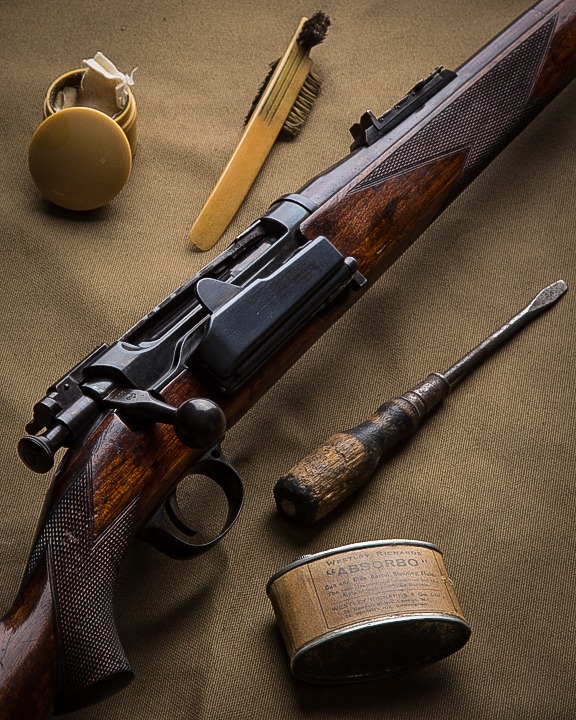
Another superb example can be found on the Nitro Express forum.
Conclusion
The Krag-Jørgensen was a visionary design when it was first created and it stands out as one of the great rifle designs of the nineteenth and twentieth centuries.
With its butter smooth action, and easy loading unique half-capsule magazine these are a delightful rifle to use.
This rifle has been a “quiet achiever”: perhaps overshadowed by some of the rifles that came after it, but nonetheless a rifle that has earned its place in history.
Picture Credits: Feature image at the head of this post of the Norwegian Krag-Jørgensen M1892 courtesy the Swedish Army Museum via Wikipedia. The other pictures are individually credited where it is possible to discover the original source.

Jon Branch is the founder and senior editor of Revivaler and has written a significant number of articles for various publications including official Buying Guides for eBay, classic car articles for Hagerty, magazine articles for both the Australian Shooters Journal and the Australian Shooter, and he’s a long time contributor to Silodrome.
Jon has done radio, television, magazine and newspaper interviews on various issues, and has traveled extensively, having lived in Britain, Australia, China and Hong Kong. His travels have taken him to Indonesia, Israel, Italy, Japan and a number of other countries. He has studied the Japanese sword arts and has a long history of involvement in the shooting sports, which has included authoring submissions to government on various firearms related issues and assisting in the design and establishment of shooting ranges.




